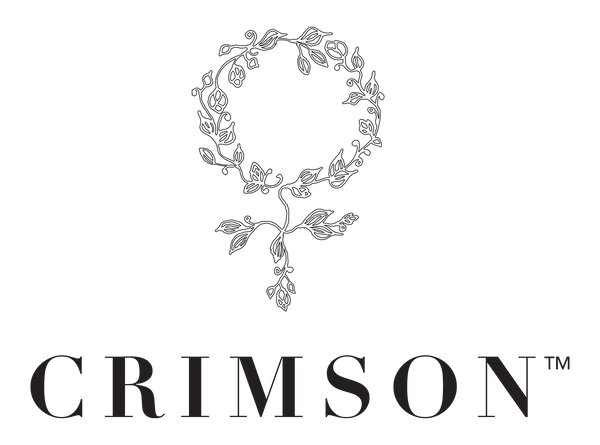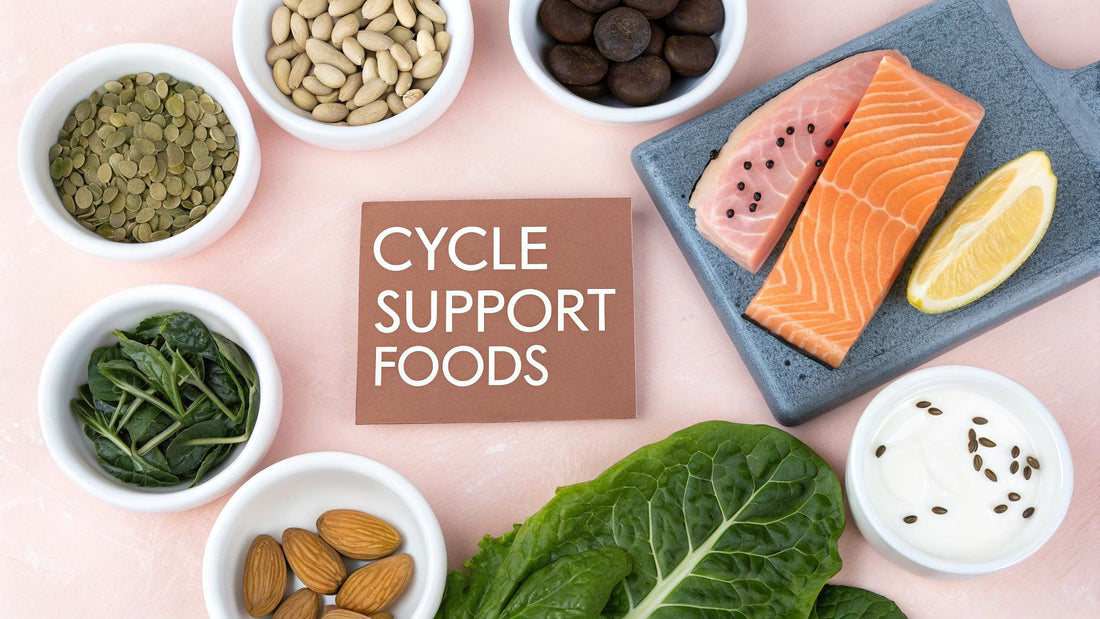
7 Foods to Help Support a Healthy Menstrual Cycle
Share
Periods can be a real pain, literally. From cramping and bloating to mood swings and fatigue, it's easy to feel like your body is working against you each month. But what if you could use something as simple as your diet to make your cycle a little smoother and more comfortable?
Here in New Zealand, conversations around menstrual health are thankfully becoming more open, tackling important issues from period equity in our communities to finding products that truly work for our bodies and values. At Crimson Organic, we believe in empowering you with both knowledge and choice, whether that’s through our certified organic digital (non-applicator) tampons or by helping you understand your body's unique needs. This guide is designed to do just that.
We will explore a curated list of powerful foods to help support a healthy menstrual cycle, offering practical, science-backed advice to help you feel your best. Forget generic tips; we’re focusing on specific nutrients that can make a real difference to common troubles like pain and low energy. Let's dive in and learn how to nourish your way to a happier, healthier period.
1. Dark Leafy Greens (Spinach, Kale, Swiss Chard)
When it comes to foods to help support a healthy menstrual cycle, dark leafy greens are true nutritional champions. These vegetables, including favourites like spinach, kale, and Swiss chard, are packed with essential minerals and vitamins that directly address some of the most common period-related troubles, such as fatigue and cramping. Their primary benefit lies in their high iron content, which is crucial for replenishing iron stores that can dip during menstruation, leading to feelings of exhaustion.
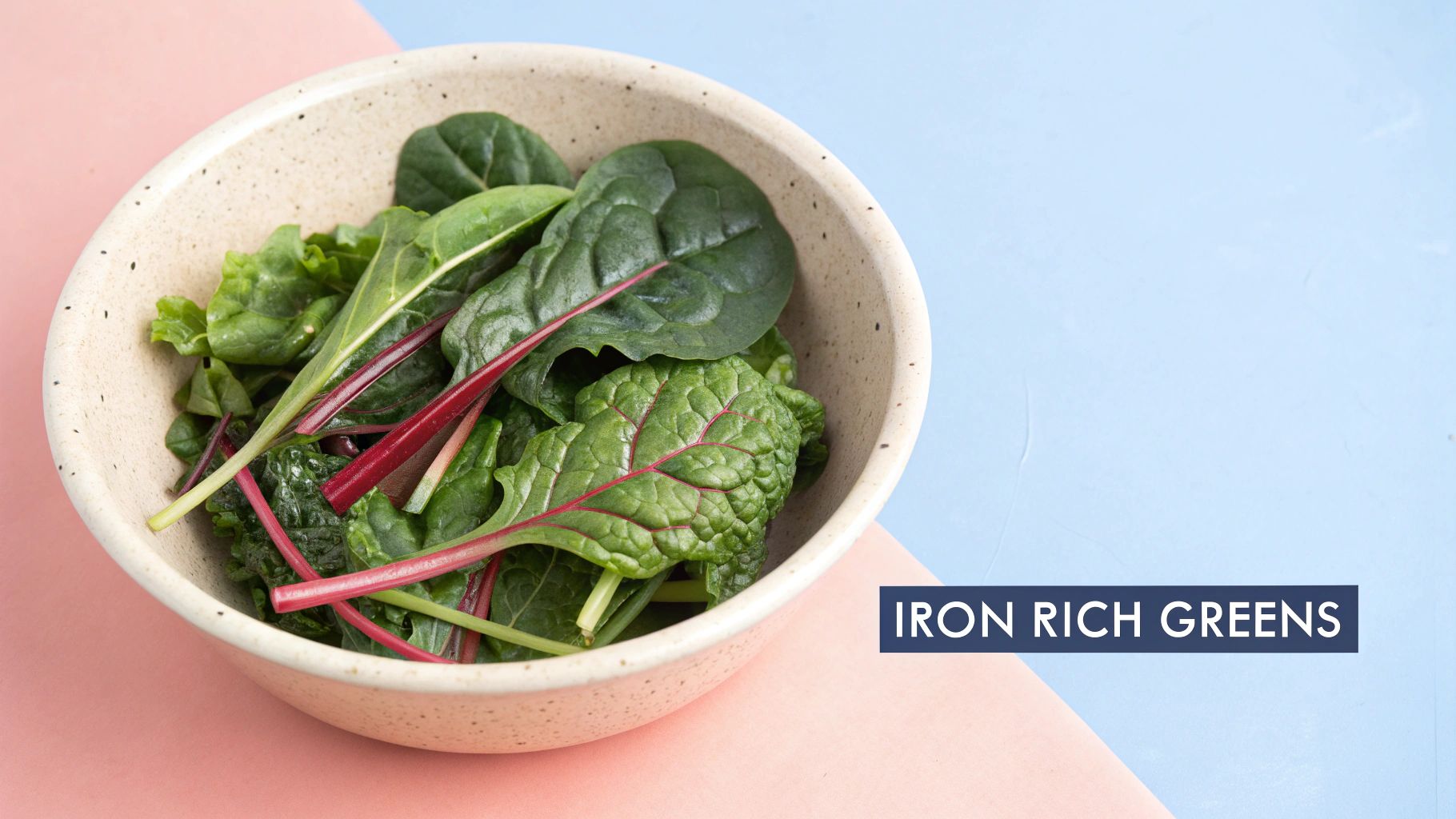
But their benefits don't stop at iron. These greens are also a fantastic source of magnesium, a mineral celebrated for its muscle-relaxing properties. This makes them a powerful ally in the fight against painful menstrual cramps. Furthermore, they contain folate (vitamin B9) and vitamin K, which support overall reproductive health and play a role in healthy blood clotting.
Why They Work for Your Cycle
Dark leafy greens help combat two of the most disruptive menstrual symptoms: fatigue and cramping. The non-haem iron found in these plants helps restore energy levels, while magnesium works to soothe uterine muscle contractions. This dual-action support makes them an indispensable part of a cycle-friendly diet. Many wellness experts and registered dietitians recommend incorporating them daily, especially in the week leading up to and during your period, to help your body feel more balanced and energised.
Practical Ways to Add More Greens
Getting more of these powerhouse vegetables into your diet doesn't have to be a chore. Here are some simple, actionable tips:
- Boost Your Smoothies: Add a large handful of fresh spinach to your morning smoothie. Paired with fruits like banana and berries, you won't even taste the greens.
- Enhance Iron Absorption: To get the most out of the iron in your greens, pair them with a source of vitamin C. Squeeze fresh lemon juice over a kale salad or add capsicum to a stir-fry with Swiss chard.
- Sauté Simply: Lightly sauté your favourite greens with a bit of garlic and olive oil for a quick and flavourful side dish that complements almost any meal.
- Meal Prep Hack: Buy pre-washed greens for convenience or freeze fresh spinach in portion-sized bags, ready to be thrown into smoothies, soups, or stews.
2. Fatty Fish (Salmon, Sardines, Mackerel)
Incorporating fatty fish like salmon, sardines, and mackerel into your diet is a powerful strategy for managing menstrual discomfort. These fish are renowned for their high concentration of omega-3 fatty acids, particularly EPA (eicosapentaenoic acid) and DHA (docosahexaenoic acid). These healthy fats possess potent anti-inflammatory properties, which can directly counteract the production of prostaglandins, the hormone-like compounds responsible for painful uterine contractions and cramps.
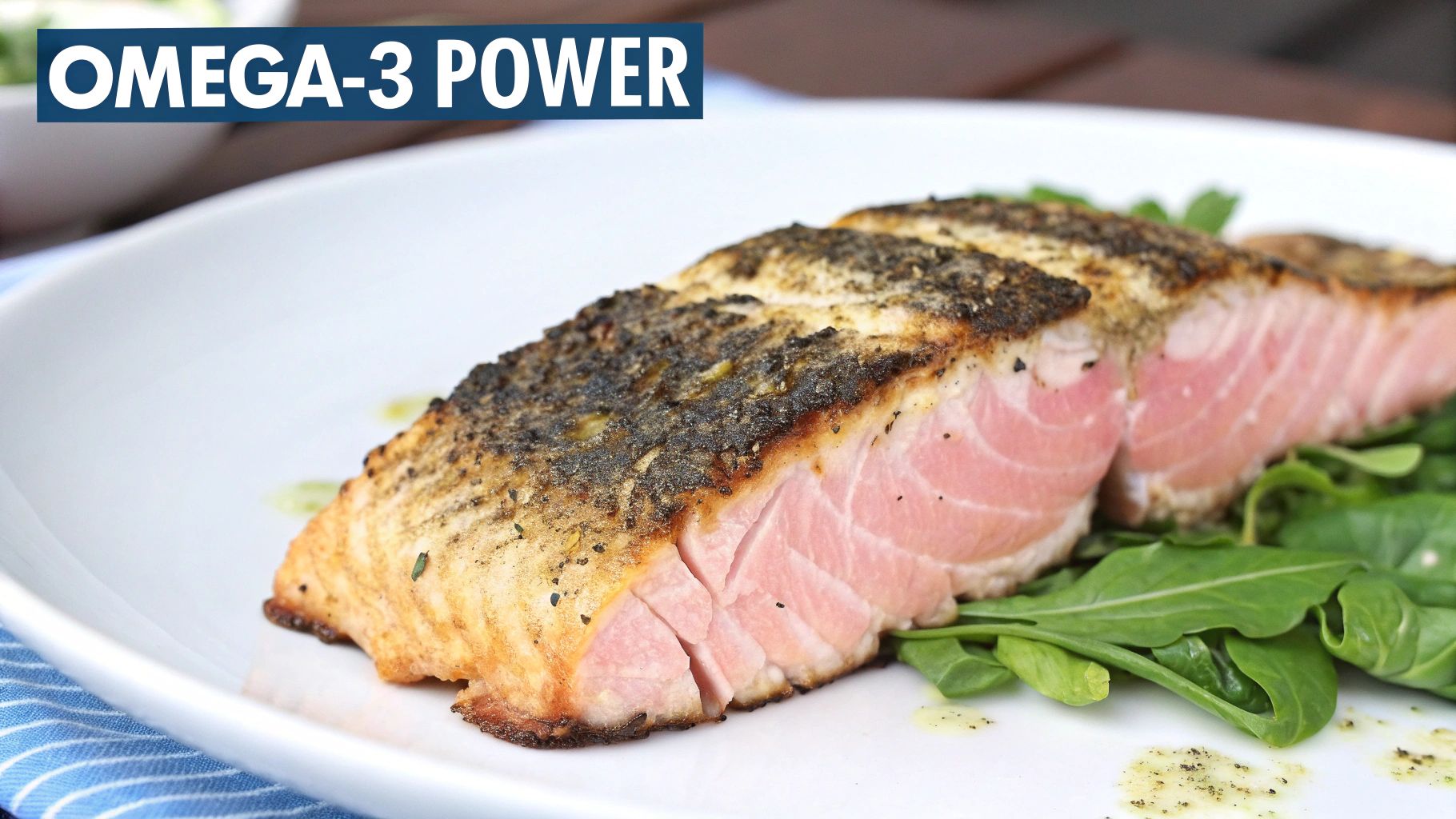
Beyond their anti-inflammatory prowess, fatty fish are a fantastic source of high-quality protein and vitamin D. The protein helps to stabilise blood sugar levels, which can curb cravings and mood swings that often arise during the luteal and menstrual phases. Vitamin D plays a crucial role in calcium absorption and has been linked in some studies to a reduction in the severity of premenstrual syndrome (PMS) symptoms, making these fish a comprehensive food to help support a healthy menstrual cycle.
Why They Work for Your Cycle
Fatty fish target menstrual health from multiple angles. The star players, omega-3s, work to reduce the intensity of menstrual pain, a benefit supported by numerous studies. Some research even suggests that regular consumption can lead to significantly fewer cramps and a reduced need for pain medication. As noted by women's health nutritionists and advocates of the Mediterranean diet, this anti-inflammatory action can also help soothe other cycle-related issues like breast tenderness and bloating. If you're interested in exploring how dietary changes can lead to fewer cramps, you can learn more about the connection between diet and lighter periods.
Practical Ways to Add More Fatty Fish
Including these beneficial fish in your meals is easier than you might think. Aim for two to three servings per week to reap the benefits.
- Convenient Canned Options: Keep canned salmon or sardines in your pantry for a quick and easy protein source. Add them to salads, mash them onto whole-grain toast, or mix them into pasta dishes.
- Simple Seasoning: A simple fillet of baked or pan-fried salmon is delicious. Season it with lemon, dill, and garlic to enhance its flavour and add extra antioxidants.
- Flavourful Fish Cakes: Make homemade salmon or mackerel patties by combining flaked cooked fish with mashed kūmara (sweet potato), herbs, and spices.
- Choose Wisely: When possible, opt for wild-caught salmon, as it typically has a higher omega-3 content and lower levels of contaminants compared to some farmed varieties.
3. Quinoa
Often mistaken for a grain, quinoa is actually a seed that has earned its place as a nutritional powerhouse and one of the best foods to help support a healthy menstrual cycle. This gluten-free pseudo-grain is celebrated for being a complete protein, meaning it provides all nine essential amino acids. This makes it an excellent choice for maintaining stable energy levels, especially when premenstrual fatigue hits. Its complex carbohydrates help to stabilise blood sugar, which can curb those intense sugar cravings that often appear before your period.
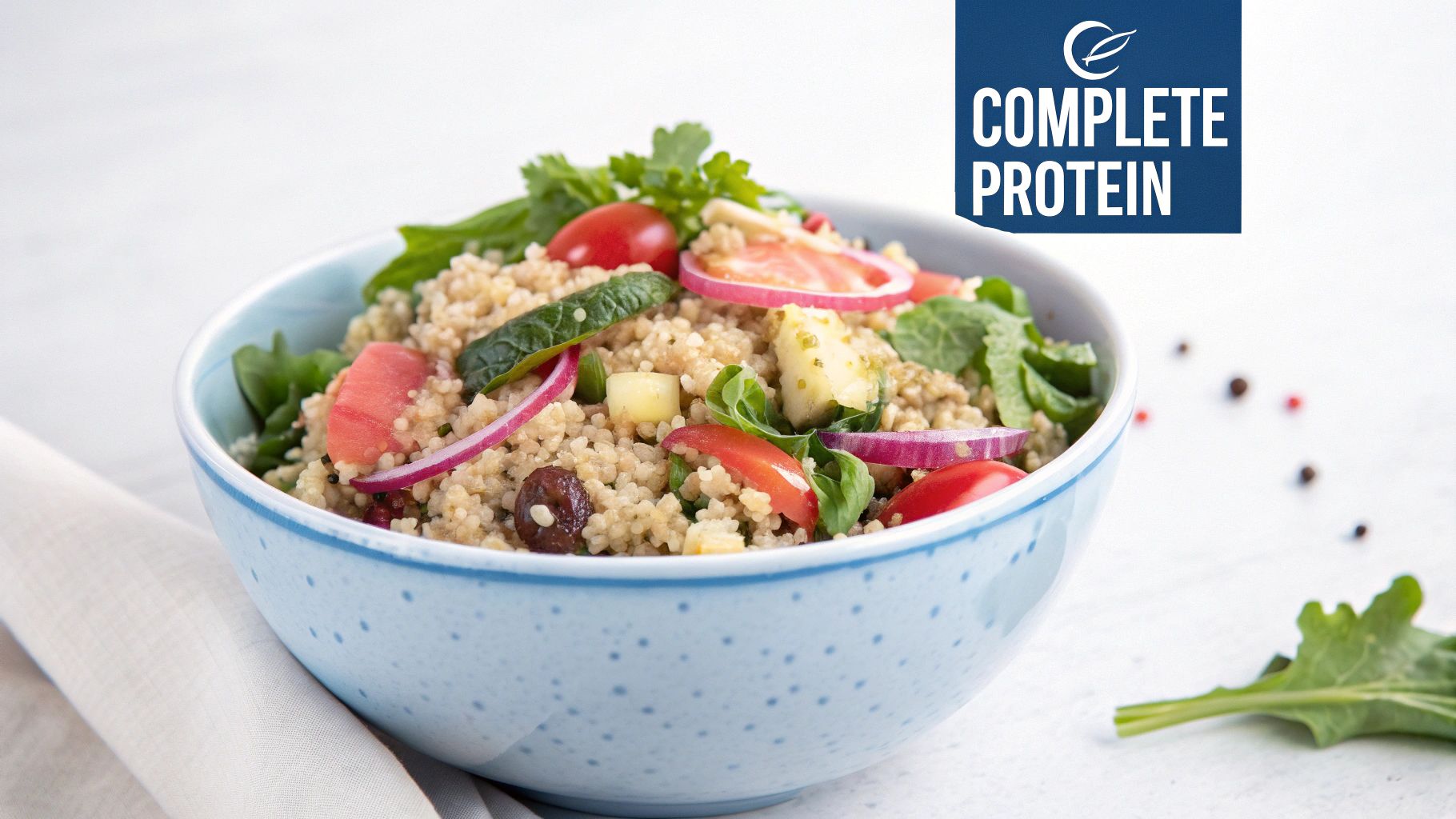
Beyond protein, quinoa is rich in magnesium and iron. Magnesium is fantastic for relaxing uterine muscles to ease menstrual cramps, while iron helps replenish stores lost during bleeding, combating tiredness and brain fog. Additionally, its high fibre content is a major asset for hormonal balance. Fibre supports the liver and digestive system in metabolising and eliminating excess oestrogen, which can contribute to symptoms like bloating and breast tenderness.
Why It Works for Your Cycle
Quinoa's unique combination of complex carbs, complete protein, magnesium, and fibre offers a multi-faceted approach to menstrual wellness. The stable energy release from its carbohydrates prevents the blood sugar spikes and crashes that can worsen mood swings. Meanwhile, the magnesium content directly addresses physical discomfort like cramping, and the fibre ensures your body's hormone-clearing pathways are functioning efficiently. Plant-based nutrition experts and functional medicine practitioners often recommend it as a foundational food in hormone-balancing protocols.
Practical Ways to Add More Quinoa
Incorporating this versatile seed into your diet is simple and delicious. Here are a few practical ideas:
- Create a Buddha Bowl: Use a base of cooked quinoa and top it with roasted vegetables, chickpeas, avocado, and a lemon-tahini dressing for a complete, hormone-supportive meal.
- Boost Your Breakfast: Swap out your usual oats for a warm quinoa porridge. Cook it with milk or a plant-based alternative and top with berries, nuts, and a sprinkle of cinnamon.
- Batch Cook for Convenience: Cook a large batch of quinoa at the start of the week. Store it in the fridge to easily add to salads, soups, or serve as a side dish with your evening meals.
- Rinse and Toast: For a better flavour and to remove the naturally occurring bitter saponins, always rinse quinoa thoroughly before cooking. Toasting it in a dry pan for a few minutes before adding liquid brings out a delicious, nutty taste.
4. Avocados
When considering foods to help support a healthy menstrual cycle, avocados are a creamy, nutrient-dense powerhouse. This beloved fruit is rich in healthy monounsaturated fats, which are fundamental for producing and regulating hormones. These fats provide the building blocks for steroid hormones like oestrogen and progesterone, helping to maintain a healthy balance throughout your cycle. They also deliver a substantial amount of potassium, a key electrolyte that helps combat period-related bloating and water retention by balancing sodium levels in the body.

Beyond healthy fats and potassium, avocados are a fantastic source of fibre, magnesium, and vitamin E. The fibre helps support healthy digestion and oestrogen metabolism, while magnesium contributes to muscle relaxation, potentially easing menstrual cramps. Vitamin E acts as a powerful antioxidant, helping to protect reproductive tissues from inflammation and oxidative stress. This unique combination of nutrients makes avocados a standout choice for overall menstrual wellness.
Why They Work for Your Cycle
Avocados offer multifaceted support by addressing hormonal balance, bloating, and cramping. The healthy fats are crucial for stable hormone production, which is essential for a regular and comfortable cycle. The high potassium content directly counters the uncomfortable bloating that many people experience, while magnesium and vitamin E work together to reduce inflammation and calm uterine contractions. As seen with hormone health coaches and wellness influencers, incorporating avocados is a popular strategy for creating a more balanced internal environment, especially during the different phases of the menstrual cycle.
Practical Ways to Add More Avocados
Adding this versatile fruit to your meals is simple and delicious. Here are a few practical ideas:
- Creamy Smoothies: Blend a quarter of an avocado into your daily smoothie for a creamy texture and a boost of healthy fats without needing dairy.
- Salad and Bowl Topper: Add sliced or diced avocado to salads, grain bowls, or on top of your favourite toast for a satisfying and nutrient-rich meal.
- Smart Shopping: Purchase avocados at various stages of ripeness so you have a continuous supply ready to eat throughout the week.
- Prevent Browning: To keep a cut avocado fresh, mash it with a little lemon or lime juice. The citric acid helps slow down the oxidation process.
5. Dark Chocolate (70% cacao or higher)
For those looking for a comforting and effective way to manage period-related discomfort, dark chocolate is a genuinely delicious solution. A square or two of high-quality dark chocolate (specifically with a cacao content of 70% or higher) is more than just an indulgence; it's a valuable source of minerals and compounds that can ease menstrual symptoms. Its power lies in its rich magnesium content, a key mineral for muscle relaxation, and its wealth of antioxidants.

Beyond magnesium, dark chocolate is packed with phenolic compounds which have anti-inflammatory properties that can help reduce the severity of period pain. It also contains anandamide, a neurotransmitter known as the "bliss molecule," which can naturally elevate your mood and combat the emotional dips often associated with PMS. This makes dark chocolate one of the best foods to help support a healthy menstrual cycle, offering both physical and emotional relief.
Why It Works for Your Cycle
Dark chocolate offers a powerful combination of benefits for period health. The high concentration of magnesium directly targets menstrual cramps by helping to relax the smooth muscle tissue of the uterus, easing painful contractions. Simultaneously, the anti-inflammatory agents help to lower the production of prostaglandins, which are compounds that trigger cramps. This dual-action relief is why many women’s health nutritionists and functional medicine practitioners recommend it as part of a cycle-supportive diet, particularly during the luteal and menstrual phases.
Practical Ways to Add More Dark Chocolate
Incorporating this beneficial treat into your diet is simple and enjoyable. Here are a few practical ways to get the most out of it:
- Choose Wisely: Opt for a bar with at least 70% cacao content. The higher the percentage, the more beneficial compounds and the less sugar it contains.
- Mindful Portions: A small amount goes a long way. Stick to a serving of 1-2 squares (around 30 grams) per day to reap the benefits without overdoing the calories.
- Power Up Your Snacks: Pair a piece of dark chocolate with a handful of almonds or walnuts for added protein, fibre, and healthy fats, which helps stabilise blood sugar levels.
- Versatile Cocoa: Use unsweetened cocoa powder in smoothies, sprinkle it over your morning oats, or mix it into yoghurt for a magnesium boost without the added sugar.
6. Lentils and Legumes
When considering foods to help support a healthy menstrual cycle, lentils and other legumes are plant-based powerhouses that deserve a prime spot on your plate. Legumes, which include lentils, chickpeas, and beans, are packed with essential nutrients that directly address common menstrual concerns like low energy and mood swings. Their primary benefit comes from being an excellent source of plant-based iron and protein, which are crucial for maintaining energy levels when you're menstruating.
Beyond iron, legumes are rich in B vitamins, particularly folate (vitamin B9). Folate is essential for healthy hormone metabolism and can play a role in easing symptoms of premenstrual syndrome (PMS). Furthermore, the high fibre content in lentils and beans is a game-changer for digestive health and hormonal balance. It helps stabilise blood sugar levels, preventing energy crashes, and supports the body's natural detoxification processes, aiding in the elimination of excess oestrogen.
Why They Work for Your Cycle
Lentils and legumes offer a multi-faceted approach to menstrual wellbeing. The combination of iron and B vitamins provides a sustained energy boost, combating the fatigue that often accompanies your period. The fibre content promotes regular bowel movements, which is a key pathway for clearing out hormones that could otherwise contribute to symptoms like bloating and cramping. Plant-based nutrition experts and registered dietitians often recommend legumes as a foundational food for hormonal health due to this incredible blend of protein, fibre, and micronutrients.
Practical Ways to Add More Legumes
Incorporating more legumes into your diet is simple and affordable. Here are a few practical tips to get started:
- Make Hearty Soups: A warm bowl of lentil soup is comforting and incredibly nourishing. This is a staple in many cuisines, from Mediterranean to Indian, celebrated for its benefits to women's health.
- Boost Iron Absorption: To maximise the plant-based iron in your legumes, pair them with a source of vitamin C. Add a squeeze of lemon to your lentil soup or serve chickpeas with a side of steamed broccoli.
- Embrace Convenience: Canned beans and lentils are a fantastic, time-saving option for busy people. Just be sure to rinse them well before use to remove excess sodium.
- Improve Digestibility: If you find legumes cause bloating, start with smaller portions. Soaking dried beans overnight and adding digestive spices like cumin or fennel during cooking can also make them much easier on your system.
7. Ginger
Ginger is a potent, warming root renowned for its powerful anti-inflammatory properties, making it an exceptional addition to a list of foods to help support a healthy menstrual cycle. This ancient remedy, used for centuries in traditional medicine, directly targets the discomfort associated with menstruation, particularly painful cramps. Its primary active compounds, gingerols and shogaols, have been scientifically studied and shown to be highly effective at reducing the production of prostaglandins, the hormone-like substances that trigger uterine contractions and pain.
Beyond its pain-relieving abilities, ginger is also a well-known carminative, which means it can soothe the digestive system. This is particularly helpful for those who experience nausea, bloating, or general digestive upset during their period. Many modern wellness advocates and naturopathic doctors recommend ginger as a natural first line of defence against period-related symptoms.
Why It Works for Your Cycle
Ginger provides targeted relief by inhibiting the biochemical pathways that lead to inflammation and pain. Research has demonstrated its effectiveness, with some clinical studies, like one published in the Journal of Alternative and Complementary Medicine, finding that ginger can be as effective as over-the-counter pain medications like ibuprofen for alleviating menstrual pain. By addressing both cramps and nausea, ginger offers a holistic approach to managing period discomfort, allowing you to feel more comfortable and in control. For more insights into natural remedies, you can learn more about effective period pain relief in NZ.
Practical Ways to Add More Ginger
Incorporating this powerful root into your routine is simple and can make a significant difference to how you feel. Here are a few practical tips:
- Start Proactively: For the best results, begin consuming ginger one to two days before you expect your period to start and continue through the first few days of your cycle.
- Brew a Soothing Tea: Steep a few slices of fresh, peeled ginger in hot water with a squeeze of lemon and a dash of honey for a comforting and effective brew.
- Use in Cooking: Grate fresh ginger into stir-fries, curries, soups, or even salad dressings to easily add it to your daily meals.
- Consider a Supplement: If you're not a fan of the taste, you can find ginger in capsule form. A common recommendation is 250mg of ginger extract taken up to four times daily during menstruation, but always consult with a healthcare professional first.
Nutritional Benefits Comparison of 7 Menstrual Health Foods
| Item | Implementation Complexity 🔄 | Resource Requirements ⚡ | Expected Outcomes 📊 | Ideal Use Cases 💡 | Key Advantages ⭐ |
|---|---|---|---|---|---|
| Dark Leafy Greens (Spinach, Kale, Swiss Chard) | Low - easy to include in meals | Low - readily available, needs frequent purchase | Improved iron levels, reduced cramps, better blood flow | Iron deficiency, menstrual cramping, general menstrual health | Rich in iron and magnesium, anti-inflammatory, versatile |
| Fatty Fish (Salmon, Sardines, Mackerel) | Medium - requires cooking/storage | Medium to High - generally pricier, needs refrigeration | Reduced menstrual pain, hormone balance, mood improvement | Menstrual pain relief, hormone regulation, PMS support | High omega-3s, anti-inflammatory, complete protein |
| Quinoa | Low to Medium - requires rinsing/cooking | Medium - more costly than grains, minimal prep needed | Stabilized blood sugar, reduced cramping, hormone balance | Blood sugar control, muscle relaxation, gluten intolerance | Complete protein, good magnesium & iron source |
| Avocados | Low - easy to eat raw | Medium - can be expensive, short shelf life | Improved hormone production, reduced bloating, sustained energy | Hormone support, anti-bloating, nutrient absorption | Rich in healthy fats & potassium, antioxidant-rich |
| Dark Chocolate (70% cacao or higher) | Very Low - ready to eat | Low to Medium - can be costly, easy to store | Reduced cramps, mood boost, antioxidant benefits | PMS symptoms, mood improvement, healthy cravings | Magnesium-rich, mood-enhancing, antioxidant-packed |
| Lentils and Legumes | Medium - soaking and cooking required | Low - affordable, shelf-stable | Improved energy, iron levels, hormone balance | Iron deficiency, blood sugar control, plant-based diets | High protein & fiber, folate-rich, affordable |
| Ginger | Low - simple to prepare/use | Low - fresh or extract widely available | Significant reduction in menstrual pain, nausea relief | Menstrual pain, nausea, digestive support | Natural analgesic, anti-inflammatory, improves circulation |
Your Plate, Your Power: A Holistic Approach to Period Wellness
Navigating your menstrual cycle doesn't have to be a monthly battle against discomfort and fatigue. As we've explored, the power to foster a more balanced and comfortable period often lies right on your plate. By consciously incorporating a variety of nutrient-dense foods into your regular diet, you can create an internal environment that is resilient, nourished, and better equipped to handle the hormonal fluctuations of your cycle. This isn't about restrictive eating or overhauling your entire life overnight; it’s about making small, sustainable swaps and additions that collectively build a strong foundation for your menstrual health.
The journey to a healthier period is a beautifully holistic one. It's about recognising the profound connection between what you consume and how you feel. From the iron-rich dark leafy greens that help replenish what’s lost during your period to the omega-3s in fatty fish that actively combat inflammation and cramping, each food we’ve discussed offers a unique set of tools to support your body. Incorporating magnesium-heavyweights like dark chocolate and avocados can ease muscle tension and improve mood, while the steady energy from complex carbohydrates like quinoa and lentils helps you sidestep those dreaded energy slumps.
Key Takeaways for Your Wellness Journey
Think of this as your new blueprint for period wellness. The most important takeaway is that consistency triumphs over perfection.
- Plan Ahead: Before your period is due, stock your pantry and fridge with supportive foods. Having ginger on hand for a soothing tea or pre-cooked quinoa ready for a quick meal can make all the difference when you're feeling tired.
- Listen Intently: Your body sends clear signals. Cravings for certain foods can indicate a need for specific nutrients. For instance, a chocolate craving might be your body’s call for more magnesium.
- Hydration is Non-Negotiable: Water is the vehicle that transports all these vital nutrients throughout your body. Aim to stay well-hydrated, especially in the days leading up to and during your period, to help reduce bloating and fatigue.
Mastering this nutritional approach is more than just managing symptoms; it’s an act of self-care and empowerment. It’s about taking control and working with your body, not against it. When you fuel yourself with intention, you're not just aiming for a better period; you're investing in your overall long-term health, enhancing your energy levels, and stabilising your mood throughout the entire month. This proactive mindset transforms your relationship with your cycle from one of dread to one of understanding and empowerment. This proactive stance on nutrition is a cornerstone of menstrual wellbeing, perfectly complementing other healthy choices, like using non-toxic, organic period care products. Ultimately, understanding how to use foods to help support a healthy menstrual cycle is a skill that empowers you month after month, year after year.
Ready to pair your nourishing diet with period care that truly supports your body and values? Explore Crimson Organic’s range of GOTS-certified organic cotton tampons and innovative period pain relief solutions, all designed in New Zealand with your health and our planet in mind. Make the switch to conscious period care today at Crimson Organic.
